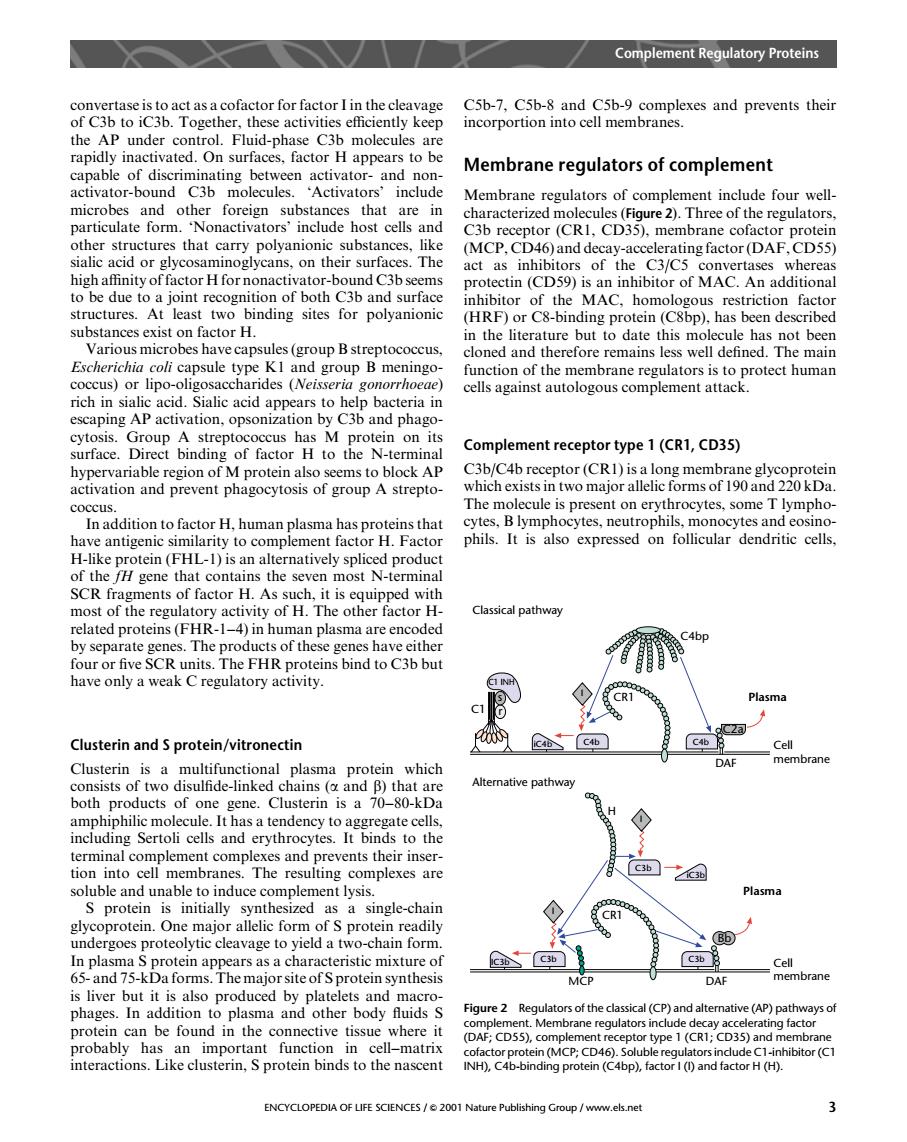正在加载图片...

Complement Regulatory Proteins Csb-7.Cs-and Csb-9 complexes and prevents their the aP under rapidly inactivated.On surfaces,factorHappears to be Membrane regulators of complement nc Membrane regulators of complement include four well- tha cells and MCP CDA or other structures that carry polyanionic substances,like CDS acid or glycosaminoglycans,on their surfaces.The act as inhibitors of the C3/Cs wherea high or Hfor nonacti otectin(CD59)is an inhibitor of MAC.An additional HR orC-n(C substances exist on factor H. ng pro t b cloned and therefore remains less well defined.The main and group B meningo function of the membrane regulators is to protect human rich in sialic acid.Sialic acid ap cells against autologous complement attac ars to he escaping AP activation,opsonization by C3b and phago bindimg ohe-eminal Complement receptor type 1(CR1,CD35) C3b/C4b receptor(CR1)is a long membrane glw protein osis of group strepto which exists in two major allelic forms of 190and 220kDa coccus The In addition to fa of the gene that contains the seven most N-termina Scr frag most ractivity of H.The other factor H the Classical pathway s(r four or five SCR units.The FHR proteins bind to C3b but have only a weak C regulatory activity C1 C2国 Clusterin and S protein/vitronectin Clusterin is a multifunctional plasma protein which DAF disulfide-linke hains( te ative pathway including Sertoli cells and erythrocvtes.It binds to the terminal complement complexes and prevents their inser membranes. @b Plasma CR protein.One major allelic form of S protein readily undergoes proteolytic cleavage to yield a two-chain form mixt Cell MC DAF mbran asma and other body fluids S Figure 2 9Ulbtosothedhstcal(CPp protein can be found in the connective tissue where it function (MCP:CD46) nhibitor(C ng proteir (C4bp)fact (0a tor H(H ENCYCLOPEDIA OF LIFE SCIENCES/2001 Nature Publishing Group/www.els.net convertase is to act as a cofactor for factor I in the cleavage of C3b to iC3b. Together, these activities efficiently keep the AP under control. Fluid-phase C3b molecules are rapidly inactivated. On surfaces, factor H appears to be capable of discriminating between activator- and nonactivator-bound C3b molecules. ‘Activators’ include microbes and other foreign substances that are in particulate form. ‘Nonactivators’ include host cells and other structures that carry polyanionic substances, like sialic acid or glycosaminoglycans, on their surfaces. The high affinity of factor H for nonactivator-bound C3b seems to be due to a joint recognition of both C3b and surface structures. At least two binding sites for polyanionic substances exist on factor H. Various microbes have capsules (group B streptococcus, Escherichia coli capsule type K1 and group B meningococcus) or lipo-oligosaccharides (Neisseria gonorrhoeae) rich in sialic acid. Sialic acid appears to help bacteria in escaping AP activation, opsonization by C3b and phagocytosis. Group A streptococcus has M protein on its surface. Direct binding of factor H to the N-terminal hypervariable region of M protein also seems to block AP activation and prevent phagocytosis of group A streptococcus. In addition to factor H, human plasma has proteins that have antigenic similarity to complement factor H. Factor H-like protein (FHL-1) is an alternatively spliced product of the fH gene that contains the seven most N-terminal SCR fragments of factor H. As such, it is equipped with most of the regulatory activity of H. The other factor Hrelated proteins (FHR-1–4) in human plasma are encoded by separate genes. The products of these genes have either four or five SCR units. The FHR proteins bind to C3b but have only a weak C regulatory activity. Clusterin and S protein/vitronectin Clusterin is a multifunctional plasma protein which consists of two disulfide-linked chains (a and b) that are both products of one gene. Clusterin is a 70–80-kDa amphiphilic molecule. It has a tendency to aggregate cells, including Sertoli cells and erythrocytes. It binds to the terminal complement complexes and prevents their insertion into cell membranes. The resulting complexes are soluble and unable to induce complement lysis. S protein is initially synthesized as a single-chain glycoprotein. One major allelic form of S protein readily undergoes proteolytic cleavage to yield a two-chain form. In plasma S protein appears as a characteristic mixture of 65- and 75-kDa forms. The major site of S protein synthesis is liver but it is also produced by platelets and macrophages. In addition to plasma and other body fluids S protein can be found in the connective tissue where it probably has an important function in cell–matrix interactions. Like clusterin, S protein binds to the nascent C5b-7, C5b-8 and C5b-9 complexes and prevents their incorportion into cell membranes. Membrane regulators of complement Membrane regulators of complement include four wellcharacterized molecules (Figure 2). Three of the regulators, C3b receptor (CR1, CD35), membrane cofactor protein (MCP, CD46) and decay-accelerating factor (DAF, CD55) act as inhibitors of the C3/C5 convertases whereas protectin (CD59) is an inhibitor of MAC. An additional inhibitor of the MAC, homologous restriction factor (HRF) or C8-binding protein (C8bp), has been described in the literature but to date this molecule has not been cloned and therefore remains less well defined. The main function of the membrane regulators is to protect human cells against autologous complement attack. Complement receptor type 1 (CR1, CD35) C3b/C4b receptor (CR1) is a long membrane glycoprotein which exists in two major allelic forms of 190 and 220 kDa. The molecule is present on erythrocytes, some T lymphocytes, B lymphocytes, neutrophils, monocytes and eosinophils. It is also expressed on follicular dendritic cells, C4b Classical pathway C1 INH C1 s r Alternative pathway iC4b C4b l CR1 C4bp DAF C2a Plasma Cell membrane IC3b C3b C3b l CR1 DAF Plasma Cell MCP membrane C3b l H Bb iC3b Figure 2 Regulators of the classical (CP) and alternative (AP) pathways of complement. Membrane regulators include decay accelerating factor (DAF; CD55), complement receptor type 1 (CR1; CD35) and membrane cofactor protein (MCP; CD46). Soluble regulators include C1-inhibitor (C1 INH), C4b-binding protein (C4bp), factor I (I) and factor H (H). Complement Regulatory Proteins ENCYCLOPEDIA OF LIFE SCIENCES / & 2001 Nature Publishing Group / www.els.net 3